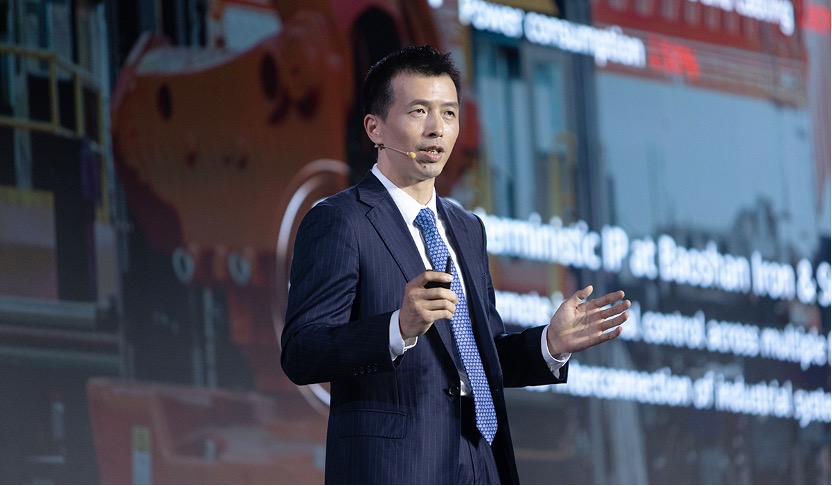The 7th Ultra-Broadband Forum (UBBF 2021), jointly organized by the UN Broadband Commission and Huawei, started on the 19th, in Dubai. The forum that this year has as its theme “Extend Connectivity, Drive Growth” has become the largest summit in the world in the field of fixed networks.
At the event, leading global operators and equipment suppliers exchanged ideas on a wide range of topics – including building network infrastructure, regional digital economy, successful solution application and expansion of industry growth space. They also shared best practices and discussed how to deepen business cooperation.

This year's UBBF takes place over two days, during which several lectures and sessions focused on fixed networks take place simultaneously. Professionals from governments, businesses, operators and academia discussed and exchanged ideas related to the current status of the development of ultra-broadband networks and the new challenges faced, while sharing related insights and success stories.
"Connectivity is more than just an expansion of functions; most importantly, it's an emotional bond.“Ryan Ding, Executive Director and President of Carrier Business Group at Huawei, said in his speech.
"More than 170 years ago, the world's first submarine cable was installed, sending the first communication signal across the ocean. This was a huge step forward for humanity. About 20 years ago, connection speeds surpassed 32 Kbps and video began to overtake text as the main form of traffic, enabling communication like never before, he added. He also stated that connectivity “makes the world a better place".
The value of connectivity is being redefined by society and industry development is accelerating. In his speech, Peng Song, president of Huawei's Global Carrier Solutions Sales and Marketing Department, defined and crafted Huawei's Coverage / Architecture / Fusion (CAF) model. Peng highlighted how connectivity must be extended within every home and every business and converge with the cloud to “meet present and future requirements”. Building connectivity competitiveness based on the CAF model is the key to new growth. "
- Coverage: Connectivity that extends to every room will significantly increase the value of home broadband. The ever-changing demands of homes and businesses require operators to extend connectivity to every room, every device, and every production system in the enterprise, and transform private lines into private networks once broader coverage is available. This will increase the number of connections, increase user adherence, and ultimately create more business opportunities.
- Architecture: Network architecture is the foundation for business success now and in the future. The new forward-looking architecture requires more elastic networks, greener services and less OPEX. Huawei will continue to explore new technologies – such as OXC, SRv6 and DNA – to strengthen the foundation of the architecture.
- Fusion: connectivity will bring great opportunities. Building network competitiveness based on the CAF model is fundamental for operators. Digitization is the biggest opportunity for the ICT industry. It evolved from a concept to a practice. It is undeniable that the cloud is at the heart of digitization, but connectivity also plays a key role. Without connectivity, “the cloud would be just a big data island”. According to Peng, “Fusion” is important because connectivity needs to be cloud-centric and help companies move to the cloud. Connectivity and the cloud need to be converged. Operators can play a big role in this process.
Kevin Hu, president of Huawei's data communication product line, explained that digitization, while increasing convenience, also presents many challenges to existing networks. For example, due to limited space within a CO equipment room, it is difficult for existing nodes to provide comprehensive service processing capabilities. Fixed homing relationships between resources and networks make it a challenge to flexibly schedule inter-DC traffic. Hybrid service operations of existing networks are ill equipped to meet today's differentiated service requirements. To address the network challenges customers face during digital transformation, Huawei introduced its smart cloud networking solution with four new features – super edge CO of all services, tenant-level hard slicing, network scheduling with SRv6 and cloud network integration. This solution maximizes the value of an operator's network resources and the complementary advantages of cloud and network, helping operators build a DICT service architecture that features cloud-network integration.
At the conference, Kevin Hu also introduced the NetEngine series smart routers for all scenarios, helping operators build smart cloud networks in the digital age. These devices include intelligent cloud access routers (NetEngine A800 series), all services aggregation routers (NetEngine 8000 M series), and intelligent backbone routers (NetEngine 8000 X16).
Today, global operators are continually increasing their investments in optical fibers, improving the quality of broadband and developing services such as FTTR and OTN premium private lines to increase fixed network revenue. As a key element of green and smart cities, all-optical target networks have gradually become an industry consensus. However, in the process of building all-optical target networks for smart cities, operators still face difficulties such as high costs, slow service delivery and difficult management of FTTH ODN construction. In addition, device deployment, network evolution and the development of new services are also pressing concerns.
At the conference, bill wang, vice president of Huawei's optical product line, said: “To overcome these challenges, Huawei launched the Digital QuickODN (DQ ODN) and Edge OTN series products. These products are designed to help operators build them all quickly - optical target networks that are visible and manageable end-to-end, significantly reduce operator O&M costs and provide a high-speed entry into the digital world for many industries and residences. They can help operators expand the enterprise market, improve the home broadband experience, reduce costs and increase revenue."
At the conference, the following notable speakers gave keynote speeches and shared their insights and successful application cases of Huawei solutions and products in the wireline domain: Doreen Bogdan-Martin (Director of ITU's Office of Telecommunications Development), Bocar A. BA (CEO of SAMENA Telecommunications Council), Ricardo Varzielas (CFO of MTN GlobalConnect), Per Morten Torvildsen (Chairman of the Board of GlobalConnect), Bader Abdullah Allhieb (Vice President of STC's Infrastructure Department), Alaa A. Malki (CTO Mobily Etihad Etisalat), and Waqar Mahmood (CTO Pakistan Higher Education Commission).
In 2014, to promote the sustainable development of the global fixed ultra-broadband industry, Huawei launched the Ultra-Broadband Forum (UBBF) with the Broadband Commission (set up jointly by the ITU and UNESCO) and leading regional operators . The forum aims to build a high-level dialogue platform focusing on ultra-broadband experience sharing, cross-sector cooperation and industry-wide promotion in order to unlock the potential of ultra-broadband and benefit operators, consumers and content providers.
UBBF has been held successfully every year since its inception in 2014 and has become the most important event leading the development of the ultra broadband industry. see more details here.







